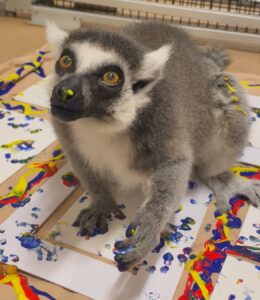Posted July 30, 2025.

A portrait of ring-tailed lemur Aristides, taken at age 31. Photo by Sarah M.
Ring-tailed lemur Aristides, one of the Duke Lemur Center’s oldest residents, died on July 21, 2025 at the age of 32.
Over the course of his three decades at the DLC, Aristides played a key role in non-invasive research studying lemur intelligence. He first made headlines in a 2004 article in DukeTODAY, where his ability to learn sequences of pictures on a touchscreen upended neuroscientist Elizabeth Brannon’s preconceived notions of prosimian cognition. Through hundreds of trials, Aristides demonstrated an ability to repeat arbitrary sequences and discriminate between quantities, getting increasingly more accurate as he “learned how to learn.” These skills indicate to scientists that our human numerical proficiency may have evolved much earlier in the primate lineage than previously believed. Aristides’s research has since been featured in a variety of publications, including the March 2008 issue of National Geographic.

The iconic cover of National Geographic’s March 2008 issue, along with Aristides’s feature.

Aristides was an intelligent lemur with a sweet personality who always loved snacking on his favorite foods. Photo by David Haring.
Beyond his contributions to science, Aristides was a beloved member of the DLC’s colony. Despite the severe arthritis he developed in his later years, Aristides never lost his zest for life. He took his pain medication willingly and eagerly twice a day (it was injected into the end of a ripe banana) and loved to spend warm afternoons sunbathing in a hammock. Aristides was always very sweet with his long-term geriatric companion, Lilah; the two could often be found grooming and cuddling in a basket together. He was also a phenomenal finger painter, always eager to sit his entire butt on the canvas in exchange for grapes.

Aristides with longtime companion Lilah in their natural habitat enclosure. Photo by Sara Sorraia.

Aristides participated in many voluntary painting sessions, using non-toxic, water-soluble paint that is safe for the lemurs to groom out of their own fur. Companion Lilah always preferred to supervise from above while Aristides painted. Photo by Abby Flyer.
In mid-July, the DLC’s veterinary team identified large masses on his liver and pancreas, indicating that Aristides was on the brink of liver failure. To prevent him from suffering, the animal care team made the decision to humanely euthanize Aristides. His final days were filled with painting sessions, all of his favorite snacks, and heartfelt goodbyes from the staff who cared for him.
Thank you so much to everyone who cared for, visited, and loved Aristides!

Aristides taking his daily medication in a piece of banana. His enclosure was retrofitted with extra ramps and structures to accommodate his aging joints. Photo by Sarah M.

